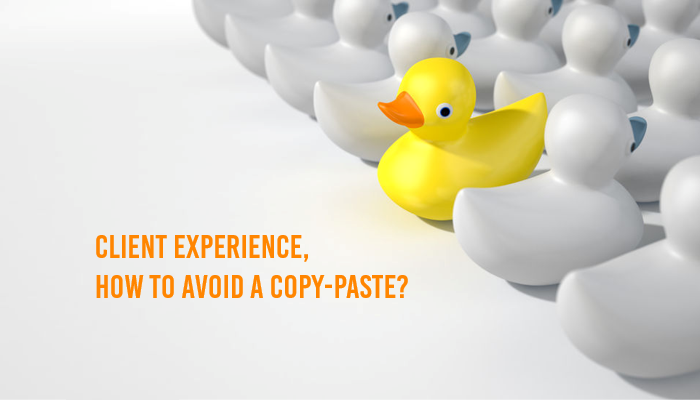Client experience, how to avoid a copy-paste?
All brands are offering a client experience, train their team on it, and it turns into the same recipe with no flavors. We call it the conformity bias.
CLIENT EXPERIENCE
Mourad Piron
8/27/20254 min read


Whatever company you are a customer of which you are a customer (or future customer), it will do everything to highlight its know-how to enchant you during your buying journey. Remember that the customer experience is what brings together all the interactions between the customer and the brand.
As discussed in the article on the power of SEO in retail, the FMOT (first Moment of truth) was the pivotal moment that the salesperson clung to to make a good first impression.
The advent of the web (and therefore of access to information via search engines) has killed the FMOT and so this moment of truth qualified as ZMOT by google (Zero Moment of truth) is now translated into a first digital impression. This "first impression" stage in the customer experience is constantly studied by any self-respecting retailer.
In luxury, it will be well-polished websites, shops that look like jewel cases, well-dressed salespeople. In mass retail, it will be the winning combination: Seller website – competitive price – Wide and deep offers.
When cognitive biases hinder the creativity of the customer experience?
Cognitive biases are shortcuts that the brain takes unconsciously and that often result in inconsistent decision-making
One in particular caught my attention: Compliance bias
"When people are free to do as they want, they usually imitate each other." (Eric Hoffer, American philosopher)
This is what conformity bias tends to show. When an individual is unsure of how to act, they will tend to rely on the advice of the majority to determine the "right" behavior to adopt. And it seems that all the departments of marketing, performance, customer excellence and training have given themselves the word: Let's differentiate ourselves by offering the same customer experience in store, on the net, in our customer service.
Result: A copy and paste regardless of the brand.
1. Social networks
Do you know a brand, luxury or not, that is not on all social networks with an account to the glory of the brand?
All this in defiance of the basic rules of social selling. Only the power of the brand counts. And the customer experience will be strengthened with brand values and story telling.
The risk: a bland customer experience because it is ultimately equal to other competing brands
2. Influencers, top models, movie stars, music stars etc
Do you know a brand that is not "married" to an influencer? a movie or music star etc? Or who has not decided to associate himself with the "face" of the moment? This same face that we will end up associating with several brands, depending on the evolution of his career or even his age.
The risk: As a brand, you decide to denounce the social and political pressure of a community, and then your "ambassadors" disappear, so as not to offend the political sensibilities of their governments.
3. The Selling Ceremony
Same refrain. Each brand is convinced to do things differently and yet, they all train their salespeople in the same ceremony: the welcome, the listening, the additional sale, the conclusion, the non-verbal, the business card, the drink offered etc. Only the uniform changes. And whether you're selling cars, fur coats, or banking, it's always the same ceremony.
The risk: experiences, it will only have the name, or we will talk about robotic customer experience. Or even sanitized.
4. Le self-service
Because we managed to convince customers that it was for their own good that they did everything by themselves. In this way, the brand will be able to reduce its costs and pass it on to its selling prices. Another argument: create your own customer experience (the famous tailor-made)
The risk: why make the effort to go to the store when I can buy online
5. Digital customer experience
Use all digital marketing tools to measure the customer's buying journey. Offer delivery costs, increase the average basket by offering rewards (delivery costs, welcome gifts, shorter delivery times, etc.). All brands do it. Probably even more so today with the pandemic.
Except that the focus is not on the customer experience but on the stubborn pursuit of always selling more. No differentiation from one brand to another. Another copy paste.
Have the courage to make your customer experience unique and differentiating
3 things to remember
Each brand must put itself in its client's shoes and apply SEO rules to its phygital approach in line with the maturity of its client .
Customer relations are above all about taking an interest in what your customer has done before entering the store. Because like 100% of French people, he first went on the internet. The question is why? Which site did he download, to be interested in what? What does he want to compare or is he ready to buy?
Cultivate difference – make it a corporate message within the company. Tolerate or even accept that this difference will help interpret the brand's DNA, everyone has their own way to make the customer experience unique.
Actually not 3 but rather 1 thing to remember
The customer experience comes from the gut. And in commerce, guts is being a trader. It is to love to serve the other. It's about being proud of your product and praising its merits, but always with a bit of empathy for the person who is going to buy it. It means ignoring cognitive biases and cultivating one's difference! Michael Aguilar talks about it very well for the sale in the pistachio effect. Everyone loves vanilla ice cream, but pistachio ice cream either you love it or you hate it. So why not put it into practice as a brand, and develop a pistachio-flavored customer experience? Get out of the cognitive bias of conformity and bet that you will either love it or hate it.
At Cloud Business School, we do tell you very much about the cognitive biases that pollute sales and consequently the customer experience.


